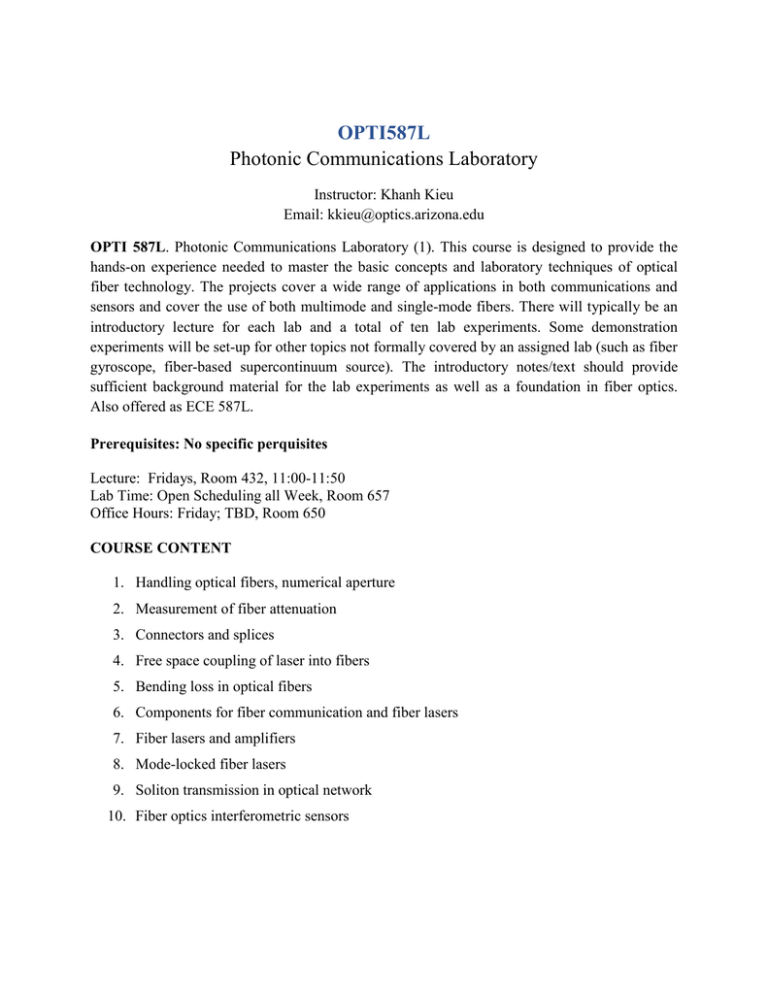OPTI587L Photonic Communications Laboratory
advertisement

OPTI587L Photonic Communications Laboratory Instructor: Khanh Kieu Email: kkieu@optics.arizona.edu OPTI 587L. Photonic Communications Laboratory (1). This course is designed to provide the hands-on experience needed to master the basic concepts and laboratory techniques of optical fiber technology. The projects cover a wide range of applications in both communications and sensors and cover the use of both multimode and single-mode fibers. There will typically be an introductory lecture for each lab and a total of ten lab experiments. Some demonstration experiments will be set-up for other topics not formally covered by an assigned lab (such as fiber gyroscope, fiber-based supercontinuum source). The introductory notes/text should provide sufficient background material for the lab experiments as well as a foundation in fiber optics. Also offered as ECE 587L. Prerequisites: No specific perquisites Lecture: Fridays, Room 432, 11:00-11:50 Lab Time: Open Scheduling all Week, Room 657 Office Hours: Friday; TBD, Room 650 COURSE CONTENT 1. Handling optical fibers, numerical aperture 2. Measurement of fiber attenuation 3. Connectors and splices 4. Free space coupling of laser into fibers 5. Bending loss in optical fibers 6. Components for fiber communication and fiber lasers 7. Fiber lasers and amplifiers 8. Mode-locked fiber lasers 9. Soliton transmission in optical network 10. Fiber optics interferometric sensors LAB REPORTS Reports should be quantitative and concise. An acceptable format for a report should include the following: • Experimental objectives – what is the purpose of the experiment and what do you hope to accomplish in the lab. 15% • Experimental Setup- Show/Explain the experimental arrangement. 15% • Experimental DATA and Analysis – Report all experimental data recorded in a clear, easy to follow format. Indicate the error margin for your data and possible sources of error. 35% • Discussion and Summary – Were the objectives accomplished? Any new ideas to improve the measurement? 35% GRADING CRITERIA • • • Lecture and lab participation 10% Lab reports 80% Final presentation 10% TEXTBOOKS: Class notes will be available online The following texts are useful: 1. G. Keiser, “Optical Fiber Communications,’’ 3rd Ed., McGraw-Hill, 2000 2. C. R. Pollock, “Fundamentals of Optoelectronics,’’ Irwin, 1995. 3. Ghatak and K. Thyagarajan, “Introduction to Fiber Optics,’’ Cambridge University Press, 1998. 4. A. Yariv, “Optical Electronics in Modern Communications,” 5th Ed. Oxford 1997. 5. G. P. Agrawal, “Fiber Optic Communication Systems,’’ 3rd Ed. Wiley Inter-Science, 2002 th 6. G. P. Agrawal, “Nonlinear Fiber Optics,” 4 Ed. Academic Press, 2006





